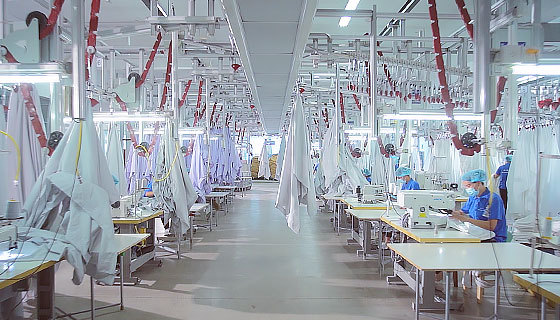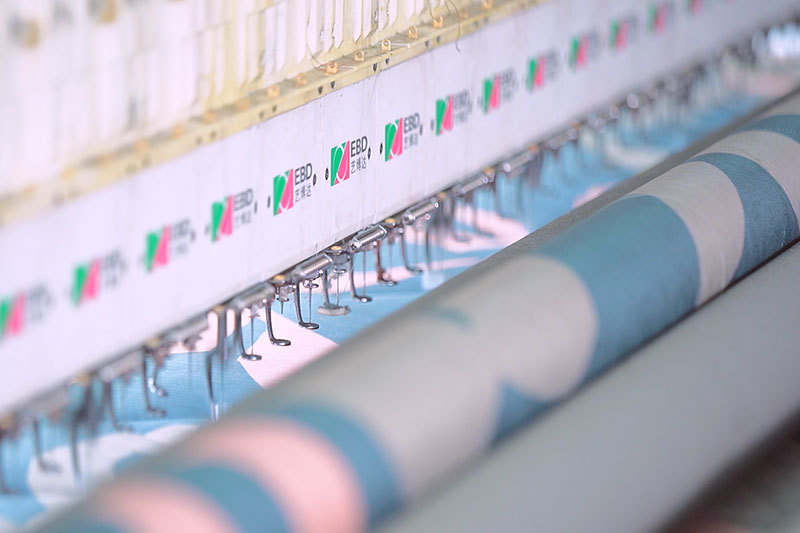Intelligent upgrade creates a new path to internationalization
2023-07-27

At present, the speed of technological innovation in various industries is accelerating. Driven by new technologies, my country's textile industry is undergoing a new round of industrial structure adjustment. With the release of the "Thirteenth Five-Year Plan for the Development of the Textile Industry", the entire Chinese textile industry has officially transformed into an intelligent and digital direction.
The development of my country's textile industry continues to accelerate, intelligent upgrades create new paths for internationalization
Since the reform and opening up, the development speed of my country's manufacturing industry has been accelerating, and many industries, including steel manufacturing, furniture manufacturing, pharmaceutical manufacturing, etc., have entered a new period of development. As a major component of the entire manufacturing industry, the textile industry has achieved certain results after decades of development. As a major component of the entire manufacturing industry, the textile industry has achieved certain results after decades of development. As a major component of the entire manufacturing industry, the textile industry has achieved certain results after decades of development.
The development of the textile industry continues to accelerate, and industry insiders are full of confidence in the future prospects
As we all know, the textile industry, as a traditional pillar industry of our country's national economy, not only plays a vital role in the development of our country's national economy, but also contributes to the growth of the world economy. At present, the output of my country's major textile products such as chemical fibers, yarns, and cloths has shown continued growth. The output of major textiles has ranked among the top in the world, and the quantity and quality of the entire textile industry have continued to improve.
In order to promote the development of the textile industry, relevant departments in my country have issued a series of policies. For example, in September 2016, my country's Ministry of Industry and Information Technology issued the "Thirteenth Five-Year Plan for the Development of the Textile Industry." According to the document, my country's total textile exports accounted for 38.60% of the world's total exports from 10.42% in 2000. This reflects from one aspect that my country's total textile exports are constantly increasing and its international trade status is constantly improving.
At the same time, the amount of fixed asset investment in my country's textile industry is also increasing, and industry insiders are full of confidence in the future development of the textile industry. According to relevant statistics from the National Bureau of Statistics: in 2005, the fixed asset investment in my country's textile industry exceeded 100 billion yuan. By 2015, the fixed asset investment in my country's textile industry had exceeded 600 billion yuan, which can be said to be growing rapidly.
At present, with the joint promotion of relevant institutions and industry insiders, my country's textile industry has entered a stage of rapid development, and the industry scale and economic benefits have also continued to grow. From 2006 to 2016, the average annual compound growth rate of my country's textile manufacturing main business revenue exceeded 10%. Although my country's textile industry has achieved certain development results, in terms of the overall development status of the industry, there are still some problems in the development process of my country's textile industry.
The development of the entire industry is facing challenges, and intelligent and digital transformation are what is needed in reality.
As far as the development model of China's textile industry is concerned, the manufacturing and production of textiles often require a large amount of labor. At this stage, China's labor costs are rising year by year and are already much higher than those in countries such as Southeast Asia and Africa. The increase in labor costs has also increased the cost of manufacturing products for enterprises, which is not conducive to the expansion of enterprise production scale and improvement of profitability. At the same time, China's current textile technology still relies on traditional hand-made production, and the overall manufacturing technology still lags far behind developed countries such as Europe and the United States.
In addition, affected by consumption upgrades, consumers' consumption concepts have undergone great changes. The entry of foreign textile brands into the Chinese market has had a certain impact on traditional domestic textile brands. When purchasing textile products such as clothing and footwear, trendy young consumers often comprehensively consider multiple factors such as the product's appearance design and fashionability. Only by keeping a close eye on market trends and building their own core competitiveness can domestic textile brands maintain a certain competitive advantage in the fierce competition.
At present, the international situation is unpredictable. In order to expand the market share of products in trade competition, countries around the world are stepping up their equipment and technology upgrades. In order to enhance competitiveness, some countries use advanced equipment to produce textiles, which effectively improves product production efficiency. At the same time, there are relatively few companies in China using new equipment for textile production, and China's textiles still face some challenges if they want to further go abroad.
In the face of challenges, it is necessary to promote the transformation and upgrading of the textile industry towards automation, digitalization and intelligence. Under the guidance of policies such as "Made in China 2025", companies can only keep pace with the times and promote the construction of smart factories in order to continuously improve the production efficiency and quality of their products. At the same time, integrating cloud computing, big data and other technologies into the development process of the textile industry can accelerate the transformation of the textile industry into a modern model.
In order to speed up the transformation and upgrading of intelligence, enterprises can set up intelligent workshops to realize the automation of the entire production process, the intelligence of control systems and the informatization of online monitoring. Taking the production process of yarn products as an example, each spindle can be connected to the Internet through sensors, and the system can monitor the operation of each spindle on the production line in real time. With the help of emerging science and technology, companies can significantly save labor costs and improve production efficiency.
As the development environment of my country's textile industry changes rapidly, companies should focus on using modern equipment such as robots to improve textile production efficiency. At the same time, combining the new generation of artificial intelligence technology with the design, production, marketing, logistics and other aspects of the textile industry can promote the transformation of the textile production model towards flexibility, intelligence and refinement. The transformation from traditional production and manufacturing to intelligent manufacturing also has Help enterprises continuously improve technology and achieve intelligent upgrades.
In the future, consumer demand for textiles such as clothing and bags will be more diversified, which will prompt the emergence of diversified textiles. Among the many textile manufacturing companies, those that focus on improving product quality and product appearance design are expected to stand out in the fierce competition and bring consumers a brand new product experience!
TAG:
Next:
Recommended
Good home textiles can also help with insomnia


















